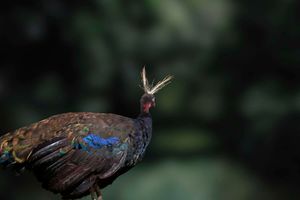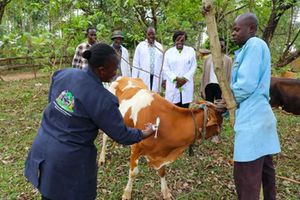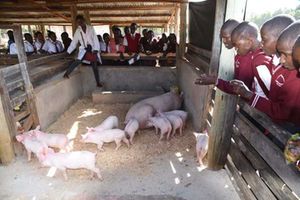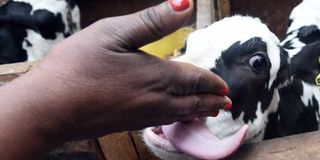
A healthy calf licks a farm attendant’s hand at a farm. Pregnant cows should be examined, with the farmer ensuring those with mastitis do not suckle their calves.
I have said before that no animal health practitioner practices enough to have all diseases and disease situations at the fingertips. Once in a while, the biological terrorists – bacteria, viruses, parasites, fungi and prions – will surprise the practitioner.
The listed groups of biological agents are collectively called pathogens or disease-causing organisms.
The complexity of pathogens and the diseases they cause depends on the nature of the pathogen, its mode of causing illness, the response of the patient in self-defence and treatment, among other factors.
Self-defence in patients is called immunology.
Immunology is the study of how the body responds to infections in order to defend itself and heal.
Usually, the body reacts by attempting to contain the pathogen at the site of entry, followed by production of chemicals called antibodies that seek to neutralise the pathogen and restore the body to health.
Unfortunately, bodies have no universal way of dealing with pathogens. Every pathogen is attacked by the body defences according to how it relates with the cells and the immune system.
Diseases that highly excite the immune system result in production of large volumes of antibodies that are able to neutralise the pathogen and heal the body with or without treatment.
Research also came up with innovations that helped to remove the infection capacity of some pathogens, keep their immunity excitement capacity but at the same time mimic mild or no sign of infection. The animal then produces antibodies and protects it from future infection challenges.
Scientifically-produced pathogens are called vaccine agents and the study of vaccines and their use is called vaccinology.
Vaccines are made from dead pathogens and are called killed vaccines. Then there are pathogens whose nature has been changed to make them less infective but still remain immunogenic. These are called the attenuated vaccines.
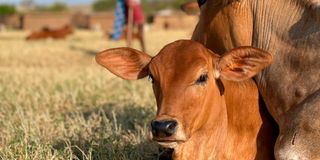
Enterotoxigenic E. coli infection can be prevented by vaccinating the mothers a month before they calve down.
There are also vaccines made from pathogens related to the disease-causing agent from another species of animal but they cause less severe disease in the species they are used. This was the case with the first vaccine against human smallpox.
The first vaccine produced was for smallpox. It was developed by Edward Jenner in 1796. He used material from cowpox sores, a less dangerous cattle disease related to smallpox in humans. Jenner’s crude vaccine protected humans against smallpox without causing cowpox.
The achievement marked a key step in the development of vaccines and vaccination. The two new terms were derived from the Latin word vaca, which means cowpox in English.
Difficult and unusual disease cases do not only come from pathogenic agents.
There are diseases and conditions that result from environmental changes, genetic make-up changes in animals, poisons and even lack or deficiency of nutrients.
In short, there are many diseases and conditions that can affect animals and people.
A medical practitioner will most likely see different cases of diseases and conditions over a long time, after working in different environments and consulting with other professionals.
Most importantly, a good professional must have an inquisitive mind and a policy to always work to their level best to ensure no case is disposed of unresolved. My case for the week has a lot to do with vaccination. Kanja called from Murang’a early this week, saying he had a difficult case of calves that were dying two to four days after birth.
Kanja is a veterinary paraprofessional I have worked with him via phone for long. He said the calves would be born healthy, suckle colostrum for 24 hours but start getting sick on the second day. They would start by losing appetite for the milk, then rapidly developing yellow watery diarrhoea, high temperature, inability to stand and then die and within one or two days after the onset of signs.
Kanja sent me photos and videos to help in diagnosis. Before he was called for the cases, some calves had been treated with antibiotic injections but that had not helped. Four calves had already died and two were sickly.
There had been 10 calves.
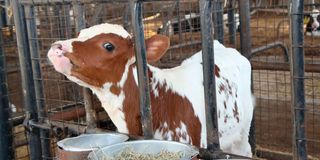
Feed the calves only on milk from clean cows.
More cows were close to calving down and Kanja said he wanted the problem solved before the arrival of the next lot of calves.
He was not sure if the remaining calves would survive.
Kanja confirmed the farm had hygiene issues but did not think they were bad enough to cause such a tragedy.
I concluded the calves were getting infected with the bacteria enterotoxigenic Escherichia coli (E. coli). I noticed some tinge of blood in the diarrhoea and the characteristic loss of energy caused by the toxin produced by the bacteria.
The rapid disease progression was also telling.
I asked Kanja to check if the calves that got sick or died had suckled from mothers with mastitis or infection of the udder. Sure enough, all the mothers had one or more teats infected and discharged milk, from at least one teat, characteristic of E. coli infection.
I advised Kanja to start feeding the calves only on milk from clean cows. The infected cows would start treatment for mastitis. The calves would be treated with antibiotics given by mouth and others injected, together with an anti-inflammatory drug.
The two sick calves would be given large amounts of oral rehydration salt solution three times a day, in addition to the other treatment, until they could drink milk and water freely.
I advised Kanja to examine the pregnant animals and ensure those infected were not allowed to suckle their calves. However, he would have to wait for the cows to calve down before beginning the mastitis treatment unless the disease was advanced.
Three days later, Kanja reported the two sick calves had recovered and none of the others had got sick.
Enterotoxigenic E. coli infection can be prevented by vaccinating the mothers a month before they calve down. The vaccine produces antibodies in the cow that are passed to the foetus, after birth, through colostrum.
I advise farmers to educate themselves about preventable diseases and routinely vaccinate their animals to reduce the cost of production and increase productivity.

